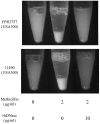Low levels of β-lactam antibiotics induce extracellular DNA release and biofilm formation in Staphylococcus aureus
- PMID: 22851659
- PMCID: PMC3419523
- DOI: 10.1128/mBio.00198-12
Low levels of β-lactam antibiotics induce extracellular DNA release and biofilm formation in Staphylococcus aureus
Abstract
Subminimal inhibitory concentrations of antibiotics have been shown to induce bacterial biofilm formation. Few studies have investigated antibiotic-induced biofilm formation in Staphylococcus aureus, an important human pathogen. Our goal was to measure S. aureus biofilm formation in the presence of low levels of β-lactam antibiotics. Fifteen phylogenetically diverse methicillin-resistant Staphylococcus aureus (MRSA) and methicillin-sensitive S. aureus (MSSA) strains were employed. Methicillin, ampicillin, amoxicillin, and cloxacillin were added to cultures at concentrations ranging from 0× to 1× MIC. Biofilm formation was measured in 96-well microtiter plates using a crystal violet binding assay. Autoaggregation was measured using a visual test tube settling assay. Extracellular DNA was quantitated using agarose gel electrophoresis. All four antibiotics induced biofilm formation in some strains. The amount of biofilm induction was as high as 10-fold and was inversely proportional to the amount of biofilm produced by the strain in the absence of antibiotics. MRSA strains of lineages USA300, USA400, and USA500 exhibited the highest levels of methicillin-induced biofilm induction. Biofilm formation induced by low-level methicillin was inhibited by DNase. Low-level methicillin also induced DNase-sensitive autoaggregation and extracellular DNA release. The biofilm induction phenotype was absent in a strain deficient in autolysin (atl). Our findings demonstrate that subminimal inhibitory concentrations of β-lactam antibiotics significantly induce autolysin-dependent extracellular DNA release and biofilm formation in some strains of S. aureus.
Importance: The widespread use of antibiotics as growth promoters in agriculture may expose bacteria to low levels of the drugs. The aim of this study was to investigate the effects of low levels of antibiotics on bacterial autoaggregation and biofilm formation, two processes that have been shown to foster genetic exchange and antibiotic resistance. We found that low levels of β-lactam antibiotics, a class commonly used in both clinical and agricultural settings, caused significant autoaggregation and biofilm formation by the important human pathogen Staphylococcus aureus. Both processes were dependent on cell lysis and release of DNA into the environment. The effect was most pronounced among multidrug-resistant strains known as methicillin-resistant S. aureus (MRSA). These results may shed light on the recalcitrance of some bacterial infections to antibiotic treatment in clinical settings and the evolution of antibiotic-resistant bacteria in agricultural settings.
Figures






Similar articles
-
Effects of Low-Dose Amoxicillin on Staphylococcus aureus USA300 Biofilms.Antimicrob Agents Chemother. 2016 Apr 22;60(5):2639-51. doi: 10.1128/AAC.02070-15. Print 2016 May. Antimicrob Agents Chemother. 2016. PMID: 26856828 Free PMC article.
-
Susceptibility patterns of Staphylococcus aureus biofilms in diabetic foot infections.BMC Microbiol. 2016 Jun 23;16(1):119. doi: 10.1186/s12866-016-0737-0. BMC Microbiol. 2016. PMID: 27339028 Free PMC article.
-
Micrococcal nuclease regulates biofilm formation and dispersal in methicillin-resistant Staphylococcus aureus USA300.mSphere. 2024 May 29;9(5):e0012624. doi: 10.1128/msphere.00126-24. Epub 2024 May 2. mSphere. 2024. PMID: 38695568 Free PMC article.
-
Correlation Between Biofilm Formation and Antibiotic Resistance in MRSA and MSSA Isolated from Clinical Samples in Iran: A Systematic Review and Meta-Analysis.Microb Drug Resist. 2020 Sep;26(9):1071-1080. doi: 10.1089/mdr.2020.0001. Epub 2020 Mar 10. Microb Drug Resist. 2020. PMID: 32159447
-
Methicillin resistance and the biofilm phenotype in Staphylococcus aureus.Front Cell Infect Microbiol. 2015 Jan 28;5:1. doi: 10.3389/fcimb.2015.00001. eCollection 2015. Front Cell Infect Microbiol. 2015. PMID: 25674541 Free PMC article. Review.
Cited by
-
Strategies to prevent, curb and eliminate biofilm formation based on the characteristics of various periods in one biofilm life cycle.Front Cell Infect Microbiol. 2022 Sep 21;12:1003033. doi: 10.3389/fcimb.2022.1003033. eCollection 2022. Front Cell Infect Microbiol. 2022. PMID: 36211965 Free PMC article. Review.
-
Multifaceted Interfaces of Bacterial Competition.J Bacteriol. 2016 Jul 28;198(16):2145-55. doi: 10.1128/JB.00275-16. Print 2016 Aug 15. J Bacteriol. 2016. PMID: 27246570 Free PMC article. Review.
-
Environmental factors modulate biofilm formation by Staphylococcus aureus.Sci Prog. 2020 Jan-Mar;103(1):36850419898659. doi: 10.1177/0036850419898659. Epub 2020 Jan 5. Sci Prog. 2020. PMID: 31902330 Free PMC article. Review.
-
Lactic Acid Produced by Glycolysis Contributed to Staphylococcus aureus Aggregation Induced by Glucose.Curr Microbiol. 2019 May;76(5):607-612. doi: 10.1007/s00284-019-01666-z. Epub 2019 Mar 20. Curr Microbiol. 2019. PMID: 30895345
-
Secreted proteases control autolysin-mediated biofilm growth of Staphylococcus aureus.J Biol Chem. 2013 Oct 11;288(41):29440-52. doi: 10.1074/jbc.M113.502039. Epub 2013 Aug 22. J Biol Chem. 2013. PMID: 23970550 Free PMC article.
References
-
- Harbarth S. 2006. Control of endemic methicillin-resistant Staphylococcus aureus–recent advances and future challenges. Clin. Microbiol. Infect. 12:1154–1162 - PubMed
-
- Mirani ZA, Jamil N. 2011. Effect of sub-lethal doses of vancomycin and oxacillin on biofilm formation by vancomycin intermediate resistant Staphylococcus aureus. J. Basic Microbiol. 51:191–195 - PubMed
-
- Subrt N, Mesak LR, Davies J. 2011. Modulation of virulence gene expression by cell wall active antibiotics in Staphylococcus aureus. J. Antimicrob. Chemother. 66:979–984 - PubMed
-
- Haddadin RN, Saleh S, Al-Adham IS, Buultjens TE, Collier PJ. 2010. The effect of subminimal inhibitory concentrations of antibiotics on virulence factors expressed by Staphylococcus aureus biofilms. J. Appl. Microbiol. 108:1281–1291 - PubMed
Publication types
MeSH terms
Substances
Grants and funding
LinkOut - more resources
Full Text Sources
Other Literature Sources
Medical
